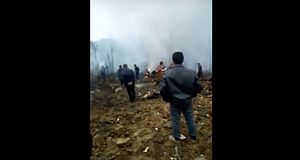On January 29, video footage, photos and posts about a plane crash went viral on Chinese social media. In the videos, an aircraft crashed, exploded, and burned flat a small bush hill right in front of local villagers who were standing close by. Other videos also depicted a dozen fire engines gathered at the rural site while billows of smoke rose from the debris.
The Chinese People’s Liberation Army Air Force (PLAAF) posted a brief statement on its official Sina Weibo account shortly after the videos surfaced, confirming that one if their planes had crashed in Guizhou province during flight training.
“Currently, search and rescue efforts are underway,” the statement said, without specifying if there were casualties or the kind of plane involved.
Before the PLAAF’s statement was released, The Beijing News (Xinjingbao) contacted local government and confirmed that the exact location of the plane crash was in Suiyang county in Guizhou.
Local media has been unable to followup on the crash so far given the sensitive nature of the incident. The Beijing News’ only report was deleted from its official website. Related video footage and photos posted on Weibo were wiped off as well, although netizens have still reposted such content sporadically.
According to The South China Morning Post, at least a dozen crew members were killed in the incident.
Citing a military source, the SCMP said the plane was “a new type of refuelling plane modified from the air force’s Y-8 transport aircraft.”
One military source told the SCMP:
There were about a dozen men and women on board and none of them managed to escape when the plane went down…There are no ejection seats on those aircraft, so the pilots and crew members would have been relying on the parachute packs on board. But they wouldn’t have had enough time to jump because the aircraft fell so fast…This type of training and education has pushed China’s aircraft development forward, but at what cost? Life is precious.
Another military source told the SCMP that “there was growing concern in the air force that there could be more accidents as flight drills were stepped up.”
Noting that “there could be more accidents in the future” both sources mentioned that the military was “under huge pressure from the top leadership of the Central Military Commission to conduct more live-fire and all-weather drills.”
Coincidently, just two days ahead of the crash on January 27, the People’s Liberation Army (PLA) announced that a Central Military Commission-approved outline for military training has been published.
Aiming to build “a strong army in the new era,” the outline vows to have “military training under combat conditions and joint training” in order to be “able to fight a war and win a war” — a slogan coined by Chinese President and Chairman of the Central Military Commission Xi Jinping.
Lieutenant General Ding Laihang — who was newly appointed by Xi as the PLAAF’s chief in September last year — also repeatedly emphasized the importance of actual combat training, saying that soldiers should “not be afraid of making mistakes or messing up” during combat training.

































